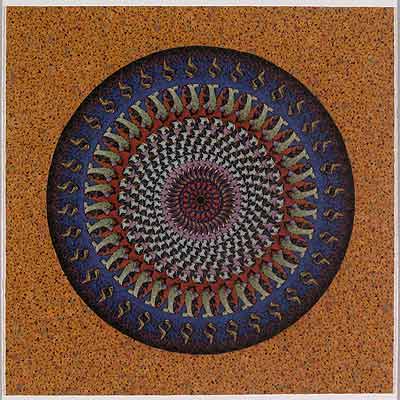Wassily Kandinsky. The Blue Mountain

Marietta Ganapin. Untitled (Blue Mountain by Vasily Kandinsky), 2004 Paper collage
Both yoga and art aim at the same thing, that is, to re-establish our personal connection with the world around us according to our own inner creativity. To render body and mind a conduit through which the creative energy can flow freely, unimpeded by outer restrictions, in the trust that this energy, being a part of the universal energy, is ultimately pure and joyful. — Dona Halleman
This is the work of sauca, “to render body and mind a conduit through which the creative energy can flow freely”. It is a noble endeavor. The asanas do much of the work for us.They cleanse the organs, the central nervous system, and the mind, while strengthening the muscular-skeletal system. Much can be accomplished through the asanas, but not all. For each of us, sauca is a journey of discovery. What works for you? Dairy, no dairy; meat, no meat; lots of sunshine, very little sun; lots of stimulation, or quiet solitude; long ambles, or power walks. We each find our own way to health and balance. Once again, we are on the path that leads to truth, and the means for determining the truth is our own individual experience. What practices render you a conduit through which the creative energy can flow freely? — Rolf Gates, Meditations from the Mat.
Marietta Ganapin is an avid museum and gallery visitor, and her relationship to specific works of art is highly personal and reverential. Her creative method is an expression of her spiritual connection to artwork that she loves. After having viewed the work of art–whether a painting, a sculpture, or decorative object–many times, she then gathers scores or even hundreds of gift-shop postcards or museum brochures which reproduce it. Using a hand-held hole punch and scissors, Ganapin creates a palette of color, pattern and form by repeatedly cutting specific areas of the reproduced image. These hole punches and cut-outs are then used as the building blocks of her designs. With great care and attention to detail, the artist transforms these elements into intricately detailed mandalas. At first, the viewer is dazzled by the obsessive and precise execution in these colorful and beautiful works. Slowly, recognizable details from the source material reveal themselves: a shank of hair in Roy Lichtenstein’s Stepping Out reads as a yellow arabesque in the concentric composition; the eyes and lips of a statuette of the Egyptian god Amun become a ring of dimensional, abstracted forms within the inner rings of the mandala structure. Yet the resultant artworks transcend mere appropriation. Ganapin’s labor-intensive execution and reverence toward her subject parallels the devotional activity of a Buddhist monk creating a sand mandala. As Ganapin has noted, “A symbol of healing, wholeness, totality and spirituality, the mandala inspires contemplation and meditation. For me, what more fitting framework than that of the mandala in reinterpreting other works of art.”
One Response
i’ve really been drawn to the idea of being a conduit in the last couple years and trust is a big part of this. i love that quote from dona halleman. thanks for sharing it!